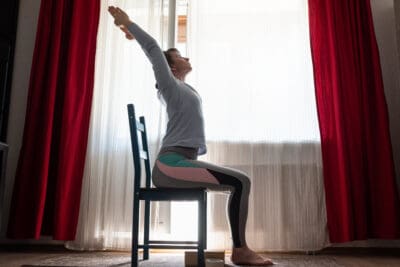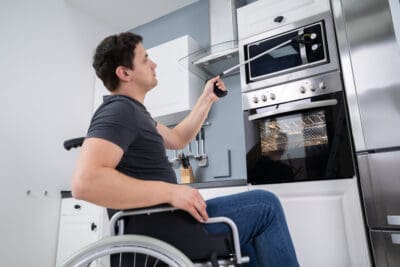Breathing For Better Mobility And Energy Conservation Techniques
The breath is a big part of yoga. The breath, or Pranyama, is the fourth of the 8 Limbs of Yoga. It is of course essential to life and, for the most part, we do it without really thinking about it. Of course, there are times when we need to focus on our breath. During yoga practice, we may increase our conscious use of the breath. Deep breathing can be used as a tool to lower our stress response. It triggers the brain to tell the rest of the body to relax. Let’s take a look at how we can breathe for better mobility, as well as some simple energy conservation techniques that can help us feel better.
We can perform deep breathing exercises anywhere- not just on the yoga mat or the yoga chair. If you are looking for a short chair yoga video that focuses on the breath, scroll to the bottom of the post for the link. The breath is a wonderful tool that we can take with us everywhere- we don’t even have to remember to pack it! When we are stressed, deep breathing activates the parasympathetic nervous system- which in turn helps to bring the body back into balance.
Deep breathing has many benefits:
- Helps us manage the stress response and creates a sense of calm
- Can assist with pain management
- Helps to increase our energy levels
- Assists with improving our sleep
- Helps us to focus
Yoga practice helps us with connecting our breath to our movement. Thereby, creating a sense of efficiency and fluidity. This allows our muscles to work effectively by reducing unneeded tension. Ever find yourself gripping something too tightly when you are stressed and trying to complete a task? Ever find that when you are stressed and trying to do something quickly, it actually ends up taking longer?
This post contains affiliate links. I earn from qualifying purchases. This means that I may earn a commission should you choose to sign up for a program or make a purchase using my link. This is at no extra cost to you. I only recommend products that I truly believe are helpful. See our Privacy Policy and Disclosures page.
Our muscle tension increases with our stress response and that increase is not always needed- and it is not always the big muscles and big movements that cause the issues. After a while, sustained and low level muscle contractions in the neck, forearms, and hands can result in pain. Breath awareness can help us tune into our physical and mental well being and guide us to achieve a better balance. There are many different breathing techniques in yoga- and some of those can take a bit of practice. But it doesn’t really have to be overly complicated to be effective.

2 Breathing Exercises For Beginners
1.Three Part Breath
- This is a diaphragmatic breathing exercise. It can be done sitting up in the chair or lying down- making it a great exercise to start or end your day.
- Begin with your hands resting on your belly. Take an inhale and feel your belly rise and expand like a balloon. Exhale as you let the belly release back towards the spine. Repeat 2-3 times
- Place one hand on the belly and the other hand on your ribs. Take an inhale and feel the belly soften and the ribs expand out to the sides (it may feel like a subtle movement). As you exhale, let the belly and the rib cage sink. Repeat 2-3 times.
- Take one hand and place it on the belly and place the other hand on the chest just below the collarbones. As you inhale, notice the belly soften and rise, the ribs expand and the chest broaden (We want the belly to rise but not the chest). As you exhale, let everything relax. Repeat 2 more times. This may take some practice- but that is okay.
2.Moving With The Breath
- While not a breathing technique, this type of breathing is meant to be performed during our yoga practice and it carries into our daily life.
- Simply put, it helps us to connect the mind to the body.
- We inhale as we expand and exhale as we contract. For example, we inhale as we open the front of the body and exhale as we compress the front of the body.
- Sit upright with a long spine with the arms by your sides.
- With the thumbs facing up, inhale to raise the arms up toward the sky (do not force or strain, only raise the arms as high as is comfortable-)
- Exhale to release the arms back down by the sides- repeat a few times and see how you feel.

There are many breathing techniques in yoga, and some involve holding the breath for a certain number of counts, or inhaling and exhaling for a particular number of counts. If you are getting started with any of these techniques, this may actually cause more stress! Remember that the breath should be free and easy and it should serve as a guide to your yoga practice (and to your life). Take a look at the energy conservation techniques below for some more tips on feeling better with movement.
Start simple, like with the above examples, and then branch out if that resonates with you. If the breath becomes effortful or labored- the body will be stressed and tense. That is not what we want. Let the breath be your guide on and off the “mat”. Research about deep breathing is growing. Take a look at this research article if you are interested in learning more: The Effect of Diaphragmatic Breathing on Attention, Negative Affect and Stress in Healthy Adults
Breathing For Better Mobility Sounds Great, But What If We Have Difficulty With Our Breathing?
So, all that sounds great but what if we have difficulty breathing because of a medical condition. There are many chronic respiratory conditions that affect our breathing and, in turn, our functional mobility. Chronic Obstructive Pulmonary Disease (COPD) is a term that describes a group of diseases that impact air flow and cause breathing issues. Emphysema and chronic bronchitis are the two most common.
Be sure to see your healthcare provider if you have concerns regarding your breathing. While there is no cure, there are many ways to manage it to improve the quality of life. Learning some ways to breathe better and implementing some simple energy conservation techniques can help. COPD causes difficulty in taking a deep breath. The changes in the structures of the lungs make it difficult for breath to be expelled- it is hard to get the air out. This can result in anxiety, panic, and stress.
You might be wondering how you can do deep breathing if you have a chronic respiratory condition? It might seem like yoga practice and breathing exercises would actually cause more stress and anxiety. Well, while we typically breath in and out through the nose with yoga, pursed lip breathing is a common tool to help those with chronic respiratory issues get the exchange of oxygen and carbon dioxide that they need if they find themselves being short of breath. By exhaling through pursed lips and extending the exhale we can allow more time for trapped air to release. You can read more about it here: Pursed Lip Breathing: Cleveland Clinic
How Can Yoga Help With Breathing Difficulties?
- Yoga brings an awareness to our posture and body mechanics that can help improve our breathing and overall function.
- Checking in with how we feel at the beginning of a yoga practice also applies to everyday life. We can take a moment in the morning or anytime throughout the day to check in with how we feel.
- Improving range of motion and core strength helps improve alignment and overall stamina. This will allow for improved activity tolerance with all our daily tasks.
- Knowing when to take a rest is vital for overall health. Yoga helps us to tap inward. Remember that yoga is individual, not a competition. It will look and feel differently everyday- just like we may feel differently everyday.
Take a look at some resources for some information and ideas for support:
COPD: Learn More Breathe Better® | NHLBI, NIH
Chronic Obstructive Pulmonary Disease (COPD) | American Lung Association
Implementing Energy Conservation Techniques For Better Mobility
Learning some energy conservation techniques can be very effective at improving mobility and helping us become more aware of our breath. Thus, allowing us to feel better as we move. Take a look at the following 12 tips for energy conservation:

1. Prioritize
Prioritize the most important tasks and complete them first, when you have the most energy in the day. Save tasks that can wait or are not time sensitive for later and don’t stress if you do not get to them today.
2. Pace yourself
This can take practice, but take your time. Rushing through to get things done does not always mean we get them done faster. When we rush we can sometimes make more work for ourselves if we make mistakes (I always manage to drop something or make a mess when I hurry). It is also a common tendency to hold our breath when we rush.
3. Simplify your space
Decrease clutter in the home to make room for you and what you need to get done. Put frequently used items within reach to avoid reaching into high cabinet shelves. Keep frequently used items in the kitchen at counter level. Ensure your space is easy to navigate.
4. Ask for help
Don’t be afraid to ask for help. Or, if you are able to, pay someone for the big projects or heavy duty tasks like house cleaning.
5. Check in with your breath
Take a moment to check in with how you are breathing to help you make your movements more efficient. Your breathe can be a good indicator of when a rest break is needed. If you are short of breath when doing any task or exercise, always stop immediately. Always consult with your healthcare provider if you have any breathing issues.
6. Have a plan
When doing a task that involves many steps, plan it out and have what you need gathered so you do not have to make more work for yourself. For instance, when showering or getting dressed- have everything you need in one place before you start.
7. Take a rest
Do not underestimate the power of taking a rest if you need to. In fact, planning for rest breaks is smart planning. Maybe you had something planned for the day but in the morning you did not feel up to it- maybe a rest is what you need. Planning for rest breaks with tasks is also a great way to implement pacing. Try not to get caught up in the mentality of trying to finish something just for the sake of finishing it. I know that it is hard to do.
8. Stop before you become fatigued
It is easy to get caught up in completing a task- but if you pass the point of being a bit tired and become fatigued- it will be harder to resume anything on that given day. Be mindful and aware of when you are getting to that point.
9. Use adaptive equipment
Utilize adaptive equipment to make tasks less taxing- reachers, long handled shoe horns, and sock aids are just a few that can help you to lessen the amount of times you bend forward – therefore affecting your breathing. Tub seats and hand held showers can also be worth the investment.
10. If possible, sit down
If you can sit to perform a task, do it (like food prep or folding laundry). Save your energy for times when you can’t sit (or just for activities that are more fun).
11. Rest after eating
Digesting takes energy. Resting for 30 minutes after eating may help you combat some fatigue. Just make sure that you stay seated upright- do not lie down.
12. Break down tasks into manageable parts
You don’t have to do everything all at once. Take a look and see if you can break it down- then implement the other tips!
I hope that you found one or two of these energy conservation techniques helpful or useful to help you or someone you care for to achieve better breath with movement. Take what resonates with you and simply leave the rest. Not all tips will work for everyone. Believe it or not, it takes time and practice to slow down.
Want More?
Again, this simple product can help with energy conservation and safety: Reacher- Be aware that this version is for small items and helping with dressing – not lifting heavy objects. There are also two lengths. If you are tall, you may consider the longer one.
If you are interested in chair yoga, take a look at this short yoga sequence with a focus on improving the breath: Yoga Sequence for Breathing
I invite you to read Chair Yoga for Healing for some simple ways to decrease stress.
Or, you may want to check out Decrease Stress With Rest
You may be interested in this simple chair yoga pose to help reset the posture and the breath: Cactus Arms.
Print or download the 12 Tips For Energy Conservation
You may be interested in my simple To Do List Notebook
Visit The Peaceful Chair Etsy Shop for Health and Wellness related printable pages and more.
I invite you to sign up for the Monthly Email Newsletter to help you stay up to date on the latest blog posts and videos.
Namaste!
Disclaimer: The Peaceful Chair and thepeacefulchair.com strongly recommends that you consult with your physician before starting this or any exercise program.The information provided on this website is for informational purposes only and is not to be used in place of medical advice or information from your healthcare provider. Neither The Peaceful Chair, the peacefulchair.com, nor any of its contributors shall be held liable for any improper or incorrect use of the information described and/or contained herein and assumes no responsibility for anyone’s use of the information contained in any links, videos, or any content on this website.

Leave A Comment